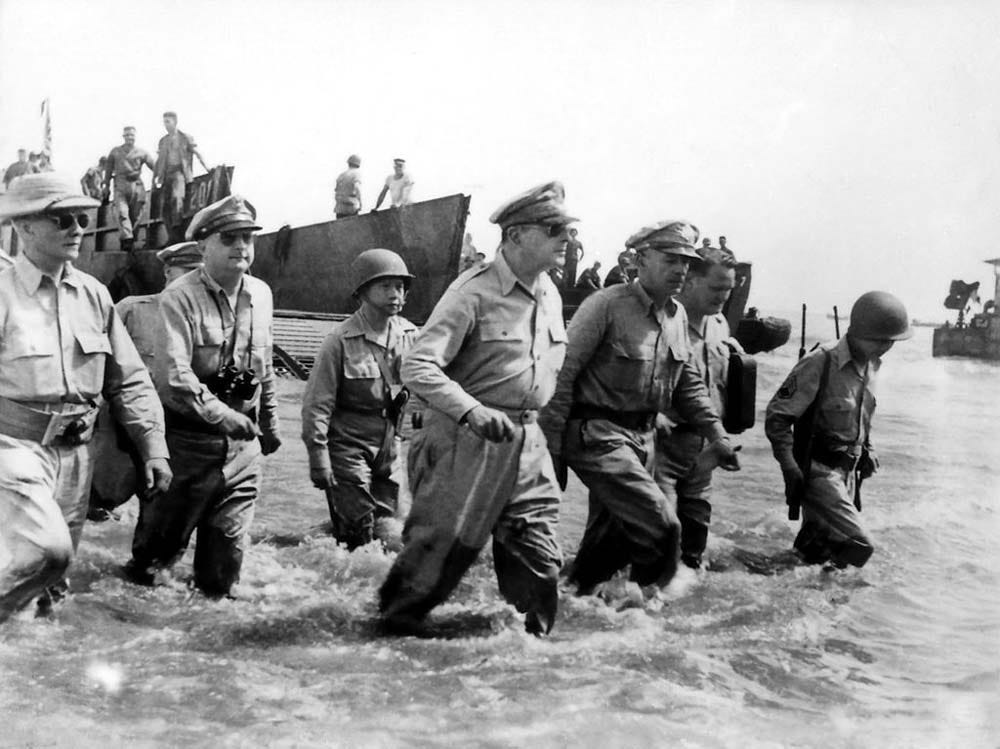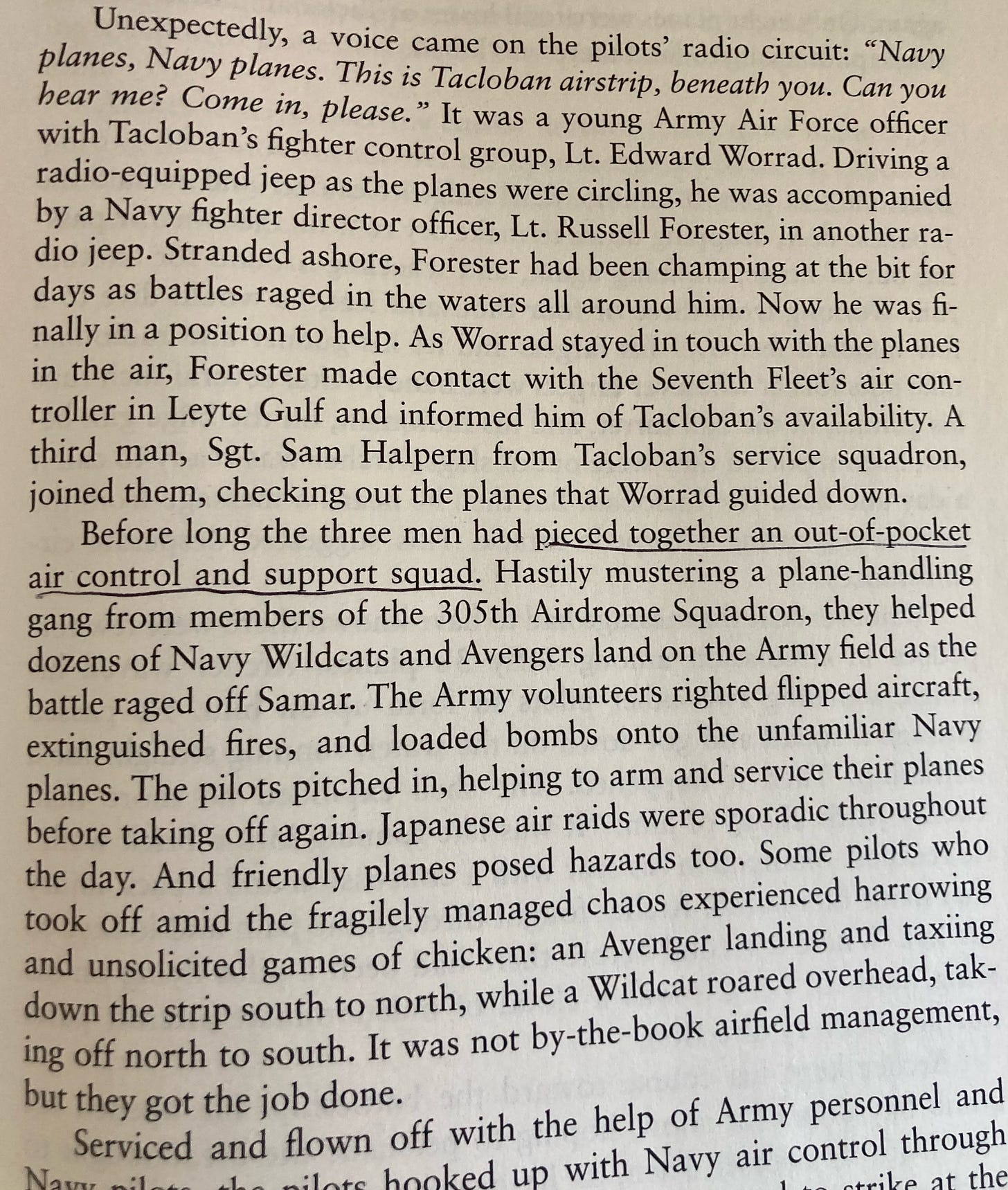Ordered Disobedience
when authority is an impediment
In October of 1944, US troops landing on Leyte Island in the Philippines were menaced from the sea by an enormous Japanese naval fleet that was divided into three separate attack forces.
Summarizing aggressively, the American ground forces were protected against an attack from the sea by the US Navy’s Third Fleet, commanded by Bull Halsey. But Halsey suddenly wasn’t there anymore, taking the bait of a decoy attack force and chasing it out into the sea. The Third Fleet’s departure uncovered Leyte Gulf, and the largest of the Japanese attack forces sailed in. Disaster became likely.
There were two American naval task forces in the path of the Japanese attack force, Taffy 2 and Taffy 3, but neither were meant for serious naval combat. They were supporting forces, designed to help the troops on the ground: a few escort carriers, a few lightly armed destroyer escorts, a very few destroyers. Aircraft on the American escort carriers were armed with 100-pound bombs to provide close air support to the infantry. The Japanese First Task Force had four battleships, eight cruisers, and eleven destroyers. One of the Japanese battleships was the Yamato, armed with 18-inch guns. The Japanese attack force sailed directly into contact with Taffy 3, which didn’t realize they were about to face the main Japanese attack force until they were already within range of its guns.
The commander of Taffy 3, Rear Admiral Clifton Sprague, saw immediately that his task force couldn’t survive the engagement, so he tried to salvage what he could: He ordered his destroyers and destroyer escorts to attack, to cover the hoped-for withdrawal of the escort carriers. The resulting battle is one of the best-known in naval history — and one of the least plausible, because Taffy 3 kicked the everloving shit out of that much larger Japanese attack force, compelling the Japanese to withdraw in the panicked belief that they’d sailed into the bulk of Halsey’s Third Fleet.
If you haven’t read James Hornfischer’s magnificent book about the battle, The Last Stand of the Tin Can Sailors, you should read it. The details are far beyond anything that could be summarized in a single short piece. But the battle was won by a remarkable combination of disciplined obedience, independent audacity, and a paradoxically disciplined disobedience — by men aggressively refusing to obey orders that threatened their cause.
The battle began with one of the US Navy’s most famous moments. Before Sprague had time to order anyone to do anything, the captain of the Johnston, one of Taffy 3’s few destroyers, turned to attack the Japanese fleet. We have confused and contradictory accounts of the orders given by Cmdr. Ernest Evans, because the man who gave them, and most of the men who heard them, died soon afterward, but he is supposed to have said something like this:
1.) We’re under the guns of a much larger Japanese fleet.
2.) Survival is not to be expected.
3.) Hard left rudder, all ahead flank.
We’re all going to die; attack. The Johnston sank, and Evans died, but his first torpedo run blew the bow off a Japanese cruiser — setting the tone of the fight.
One of the reasons the Japanese believed they’d sailed into Halsey’s main fleet was the ferocity of the air attack — which, remember, was carried out by planes equipped with light bombs for close air support of ground forces, almost completely meaningless against warships. The pilots dropped those bombs anyway, and made strafing runs, and then buzzed the Japanese ships without bullets or bombs to keep up the impression that the attack was continuing. Some accounts say that pilots drew their sidearms, opened their canopies, and shot at Japanese sailors with revolvers.
And here we come to the most telling moment. As navy planes ran out of ordnance and then ran low on fuel, and as their escort carriers weren’t in a position to bring them back aboard, the pilots looked inland — and found the US Army Air Force carving out a new airport, with stores of ordnance and fuel already in place, in the Leyte Island rainforest. Navy planes began to drop in unannounced on an army facility, and army crews rushed to help them. Until the commander of the airfield, an army major, intervened. You can find this encounter in Chapter 29 of Hornfischer’s book, with an account of what the major said to the first navy pilot who reached him: “I can’t give you this stuff. I’ve got planes coming here in seven to ten days — P-51s and P-47s — and these bombs are for them.”
“That’s just too bad,” Lt. (jg) Thomas Lupo replied, and held the airfield commander at gunpoint, understanding that the major wasn’t going to live long enough to see those P-51s and P-47s if the Japanese fleet held Leyte Gulf. Lupo’s commitment to his country and its cause led him to threaten to shoot a superior officer if he interfered any further with an off-the-books but critical military operation. It was a loyal armed robbery. The army ground crews and the navy pilots went on fueling and re-arming the navy planes:
There were many of these moments, and I encourage you to read the book to find more of them. (Look for the name of Lt. Robert Browne.) They continued: After the battle, a landing craft departed Leyte Island to search for survivors in the water. The ranking officer, convinced they’d searched long enough without success, ordered the helmsman to turn around and head for home. His subordinates repeatedly ignored his increasingly angry direct orders, until they found survivors and took them aboard. They were loyal and obedient, but somewhat more of the former than the latter.
And so on.
In the face of authority that loses the plot and fails its duty, mindful disobedience is an expression of a larger faith: in a country, in a community, in a people. There might be times when you find this idea useful.



Those were different men in a different time.
But we'll see.
Beautiful read nonetheless. Thanks.
My father was born in 1925 and was raised by a single mom during the depression. At age 17 in 1942 he enlisted in the US Navy and became a corpsman (the S is silent Barack). He ended up in the South Pacific assigned to the Marine Corps medical service and was in the battle for Iwo Jima among other postings. He spent 20 years in the Navy/Marines and was part of helping evacuate our forces from the Chosin Reservoir in Korea. I was raised to support and defend this country and until about ten years ago I strongly did that. My dad died in 1993 and I am glad he can’t see the shit show it has become and all the lives we have wasted at home and abroad in the last 20 years.